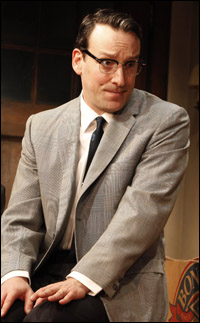
*
Ask Playbill.com answers your (and sometimes our own) theatre-related questions. To ask a question, email [email protected]. Please specify how you would like your name displayed and please include the city in which you live.
Question: We loved the ideas and personalities in Clybourne Park, and we got curious about playwright Bruce Norris using the setting and a character from A Raisin the the Sun as the launch pad for his play. Did he get permission or pay a royalty to the Lorraine Hansberry estate for use of elements from the 1959 play, or is the copyright law flexible since the play might be considered a satire? — P.T., Athens, OH
Funny you should ask. We were curious about that, too, so when we recently interviewed playwright Norris, we asked him.
Clybourne Park, which won the 2011 Pulitzer Prize for Drama and is currently playing on Broadway, takes its initial inspiration from Lorraine Hansberry's classic 1959 tale of black life in America, A Raisin in the Sun. That play, which is focused on the struggles of the Younger family, had a single white character. That is Karl Lindner, a bigoted representative the all-white neighborhood — Clybourne Park — where the African-American Youngers plan to move. He visits the family in an effort to convince them to stay put, in their own neighborhood.
 |
||
| Jeremy Shamos as Karl in Clybourne Park. |
||
| photo by Joan Marcus |
Norris said he did not ask the permission of the Hansberry estate. "We await the lawsuit," he joked.
Norris said he felt he was on pretty safe ground. He cited the famous case of "The Wind Done Gone," a 2001 novel written by Alice Randall, and published by Houghton Mifflin, which plays off characters and situations from Margaret Mitchell's "Gone With the Wind." The story is told from the viewpoint of Cynara, a slave who is the daughter of Scarlett O'Hara's father and Mammy, making her Scarlett's half-sister. Though the source inspiration of the book is obvious, Randall avoids using the names of Mitchell's characters.
"Margaret Mitchell's estate sued," said Norris, saying "The Wind Done Gone" infringed on the copyright of "Gone With the Wind." "But the book didn't use any of Mitchell's text, just ideas and characters." Houghton Mifflin's lawyers argued that the book was a parody. In 2011, the U.S. Court of Appeals overturned a lower court's injunction against publishing "The Wind Done Gone." One year later, Mitchell's estate dropped the litigation when Houghton Mifflin agreed to make an unspecified donation to Morehouse College, an all-male, historically black college in Atlanta.










